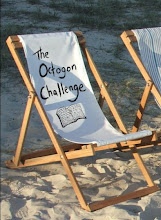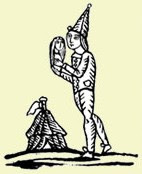I had read a number of blog reviews about this one last year. The white laboratory-like cover coupled with my weakness for a dystopian novel attracted me, and then the premise sealed the deal. I sent for it right away. The time for reading it only came recently.
Set in Sweden in the near future, Dorrit, our main character, tells her story in the first person. We enter her world while she is waiting outside her ramshackle cottage for a large car with blacked-out windows to arrive and take her and her meagre luggage away. She is going to The Unit, an establishment in an unknown part of the country that voluntarily houses women over 50 and men over 60 in constant luxury for the remaining part of their lives. In this society older citizens without children or dependents and without a progressive job, are considered to be a drain on the whole and therefore dispensible, and being unnecessary in this way are largely ostricised and unable to get financial help in any form. The alternative is to opt for The Unit, a huge, enclosed place with theatres, art galleries, sports facilities, cinemas, cafes, therapies, restaurants, dancing, parties, enormous gardens... it goes on, and all without money or financial worries. The catch is that to become necessary to society you have to take part in medical experiments, gentle ones at first to ease you in, then you start donating parts of yourself, to enable the necessary members of society to live. Eventually, on average after 4 years in The Unit, you will make a final donation ending your life. These final donations, such as a heart and lung transplant, will only be considered when all other avenues have been explored, but everyone at The Unit knows that their day will come, voluntarily or not, and this is their contribution to society.
Already this scenario throws a lot of questions into the mix, and then it complicates it further because all of the people in there are artists, writers, sculptors, photographers, from the creative sides of life and therefore have a lot in common. For probably the first time in a long time they have support, from each other, friendship, common-ground, and even love. What if, in an alienating world, the first time that you truly encounter humanity is when your days are numbered? What then?
We explore all of this through Dorrit's eyes. All of her questions about how she ended up in this situation, agonizing over saying goodbye to her life outside, where her mother had encouraged independence, and a terminated pregnancy while a student had jeopardised forming attatchments, so that when this regime, at first loathed as extreme, but gaining favour until finally attaining power, came about, she was on the wrong side of the policies and labelled 'unnecessary'. Now, on the inside, the unthinkable happens. Dorrit finds love and more, but where to go now?
I knew this would be a hard read, dystopian novels usually are, but I did not expect it to be so overwhelmingly sad. The sparse and economical writing makes it even more heartbreaking. I must have been in tears about 5 times during its duration, I had to stop reading it on the bus to and from work. It is unbelievably sad, and unexpectedly so. Futuristic society novels can sometimes have a coldness that enables you to distance yourself a little from them but I found this to be the opposite. I totally identified with Dorrit, I was in her world immediately, and although it is a different kind of world, it was not so far away as you would think. Peoples kindness comes through and far from being clinical, The Unit is a reasonably safe environment, and supposedly voluntary, presenting you with so many grey areas from which to explore your ethical standpoint. Of course it is despicable, but it is dressed up in a way that makes you consider the option with much more to go on, than in say Never Let Me Go by Kasuo Ishiguro, which explores similar but ultimately different themes.
I loved this book, it sucked me in from the first page and made me feel so much. I identified with many of the characters (if it were a true scenario I could very well be headed to The Unit myself in the not too distant future), it gave me so many powerful things to think about, and I found myself considering it when not reading it too. But mostly it was the emotional ride I was not expecting and it is this that gave me such a fruitful read. Any book that makes you think and feel is a winner to me and I certainly enjoyed this one.
It would be a great title for reading groups with so much to debate. A Reading Group Guide can be found for The Unit here.
Ninni Holmqvist is a featured author on GoodReads, use the link to read more.
This book was read for #6 of my personal challenges to read at least one dystopian novel this year.
Quote
The true university these days is a collection of books.
-Thomas Carlyle
-Thomas Carlyle
Sunday, 27 May 2012
Friday, 18 May 2012
4th Blogiversary
Yes its true, The Octogon has been here in this spot for 4 years and it has been great fun.
I have made lots of blogging friends, taken part in all sorts of online events, as well as loads of lovely books that have come my way too.
This blog has helped me organise my reading, but has also encouraged my Novel Holidays, BookSwaps and various events and discoveries along the way. In some ways The Octogon has been the sun around which all of these other things have revolved.
At the beginning, in 2008, when I posted for the first time, I really did not know where I was going with this, but it has evolved and taken on a life of its own and I can only hope that I will be here with you for some time to come.
Many thanks to all of you who stop by to read, comment and encourage. As you all know, blogging is a huge community and I am very glad to have my own little space within it.
I have made lots of blogging friends, taken part in all sorts of online events, as well as loads of lovely books that have come my way too.
This blog has helped me organise my reading, but has also encouraged my Novel Holidays, BookSwaps and various events and discoveries along the way. In some ways The Octogon has been the sun around which all of these other things have revolved.
At the beginning, in 2008, when I posted for the first time, I really did not know where I was going with this, but it has evolved and taken on a life of its own and I can only hope that I will be here with you for some time to come.
Many thanks to all of you who stop by to read, comment and encourage. As you all know, blogging is a huge community and I am very glad to have my own little space within it.
Monday, 14 May 2012
The Unforgotten Coat by Frank Cottrell Boyce
This book was given to me as a promotional copy during World Book Night 2011 and I have only recently got around to reading it. I have read some short stories and a play script by Frank Cottrell Boyce before so I happy to receive this one.
Written for younger readers we follow the story of Julie, a North Liverpool school girl who becomes friends with two newcomers to her school, Chingis and Nergui, who are from Mongolia and join the class for a while. Julie is fascinated by the new classmates, who talk of wide open plains and training eagles and she wants them to feel welcome. Assigned as their guide in their new school she becomes part of their world for a short time and the three of them become unlikely friends.
The book is set out like a school exercise book complete with discoloured pages and glued in pictures. Told in the first person Julie is likeable and felt instantly familiar. The language helps you identify easily with school life and the mysterious brothers arouse your curiosity with ease. Told with compassion and warmth this story has lessons for all of us. For a childrens story I felt quite emotional by the last few pages.
I finished this book in a day and I enjoyed the characters and also the look of the book. It is about friendship, diversity and being proud of your roots. There were quite a few surprises along the way, plot turns that were unexpected, especially the ending. A valuable book for young teens, but also for us older ones with a need to read quality writing.
It is thanks to The Reader who produced these free copies as part of Our Read 2011 that I ended up with this copy.
Written for younger readers we follow the story of Julie, a North Liverpool school girl who becomes friends with two newcomers to her school, Chingis and Nergui, who are from Mongolia and join the class for a while. Julie is fascinated by the new classmates, who talk of wide open plains and training eagles and she wants them to feel welcome. Assigned as their guide in their new school she becomes part of their world for a short time and the three of them become unlikely friends.
The book is set out like a school exercise book complete with discoloured pages and glued in pictures. Told in the first person Julie is likeable and felt instantly familiar. The language helps you identify easily with school life and the mysterious brothers arouse your curiosity with ease. Told with compassion and warmth this story has lessons for all of us. For a childrens story I felt quite emotional by the last few pages.
I finished this book in a day and I enjoyed the characters and also the look of the book. It is about friendship, diversity and being proud of your roots. There were quite a few surprises along the way, plot turns that were unexpected, especially the ending. A valuable book for young teens, but also for us older ones with a need to read quality writing.
It is thanks to The Reader who produced these free copies as part of Our Read 2011 that I ended up with this copy.
Monday, 7 May 2012
Trip to Haworth, Bronte Country
Our trip to Haworth in Yorkshire to visit the home of the Brontes took place over the last weekend in April and we had a great time. We stayed in a B+B in Haworth itself, a quaint little town on the edge of the moors with a steep cobbled High Street made famous in the old Hovis adverts.
Most people visit Haworth because it is the main place that the Bronte family lived after their father was appointed Rector of Haworth church in 1820 with his wife and six children. Sadly he outlived all of them, but his three daughters acheived some of the greatest writing that England has ever known during their short lives.
The town itself is quite small but has a healthy dose of quirky shops, restaurants and decent pubs. There is a lovely second hand bookshop there too. You can be delivered by steam train on the Keighley and Worth Valley Railway (also famous for The Railway Children) at the bottom of the town and climb your way up the main street to the tourist information at the top. The major draw is the Bronte Parsonage, now owned by the Bronte Society and a museum celebrating its famous family. A beautiful house of Yorkshire stone set beside the atmospherically gothic cemetary and small church it does not disappoint. Emily and Charlotte are buried in the church, as are the other members of the family. Anne is buried in Scarborough.
The museum itself is excellent with many original artifacts, clothing, letters, possessions. Not only is it all authentic and informative, but it accurately sets the scene for Bronte fans to get lost in. I was also impressed with the deatails of how the Bronte society secured many of the articles to be brought back and put in their rightful place.
Haworth has quite a history apart from its literary connections, and a walk around the graveyard conveys this with the high mortality rate, especially with children, and even a stone for an executed highwayman. Indeed the graveyard probably contributed to the early deaths of the Bronte sisters because it was condemned as a health risk in the late 19th century due to its severe overcrowding and lack of trees to aid decomposition (the trees were added afterwards). The 'black ooze' the came up in the ground probably contaminated the water supply to the poorer end of town, and possibly the well in the Bronte garden.
Also recommended is the walk across the moors to Top Withens, an abandoned farmhouse that is said to have influenced the setting of Wuthering Heights, more for its bleak position than any exact replication. Nevertheless, it is a lovely walk (about 7 miles full circle) taking in the Bronte waterfalls, the moors (it was suitably windy and rainy when we were there), and also a Quaker buriel ground and other fascinating places with stories behind them. There is a pub on the last part of the walk which was good timing for a pitstop and a pint.
While we were there my friend and I had some discussion comparing Wuthering Heights to Jane Eyre, both of which we made sure we read before going which added to our weekend.
Haworth is an essential destination for Bronte fans but also highly recommended for literary fans generally, as well as anyone who enjoys a good starting point for walks on the Yorkshire moors.
Most people visit Haworth because it is the main place that the Bronte family lived after their father was appointed Rector of Haworth church in 1820 with his wife and six children. Sadly he outlived all of them, but his three daughters acheived some of the greatest writing that England has ever known during their short lives.
The town itself is quite small but has a healthy dose of quirky shops, restaurants and decent pubs. There is a lovely second hand bookshop there too. You can be delivered by steam train on the Keighley and Worth Valley Railway (also famous for The Railway Children) at the bottom of the town and climb your way up the main street to the tourist information at the top. The major draw is the Bronte Parsonage, now owned by the Bronte Society and a museum celebrating its famous family. A beautiful house of Yorkshire stone set beside the atmospherically gothic cemetary and small church it does not disappoint. Emily and Charlotte are buried in the church, as are the other members of the family. Anne is buried in Scarborough.
The museum itself is excellent with many original artifacts, clothing, letters, possessions. Not only is it all authentic and informative, but it accurately sets the scene for Bronte fans to get lost in. I was also impressed with the deatails of how the Bronte society secured many of the articles to be brought back and put in their rightful place.
Haworth has quite a history apart from its literary connections, and a walk around the graveyard conveys this with the high mortality rate, especially with children, and even a stone for an executed highwayman. Indeed the graveyard probably contributed to the early deaths of the Bronte sisters because it was condemned as a health risk in the late 19th century due to its severe overcrowding and lack of trees to aid decomposition (the trees were added afterwards). The 'black ooze' the came up in the ground probably contaminated the water supply to the poorer end of town, and possibly the well in the Bronte garden.
Also recommended is the walk across the moors to Top Withens, an abandoned farmhouse that is said to have influenced the setting of Wuthering Heights, more for its bleak position than any exact replication. Nevertheless, it is a lovely walk (about 7 miles full circle) taking in the Bronte waterfalls, the moors (it was suitably windy and rainy when we were there), and also a Quaker buriel ground and other fascinating places with stories behind them. There is a pub on the last part of the walk which was good timing for a pitstop and a pint.
While we were there my friend and I had some discussion comparing Wuthering Heights to Jane Eyre, both of which we made sure we read before going which added to our weekend.
Haworth is an essential destination for Bronte fans but also highly recommended for literary fans generally, as well as anyone who enjoys a good starting point for walks on the Yorkshire moors.
Labels:
Bronte Parsonage,
Brontes,
Haworth,
Jane Eyre,
Novel holiday,
Top Withins,
Wuthering Heights
Subscribe to:
Posts (Atom)
Hay on Wye



























